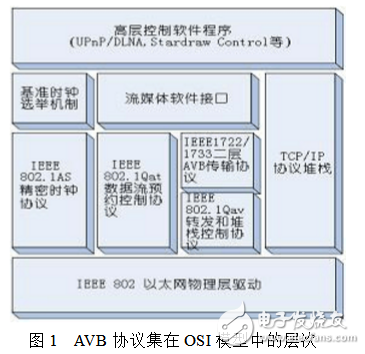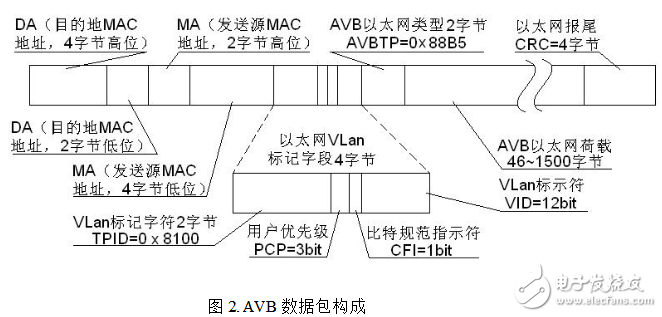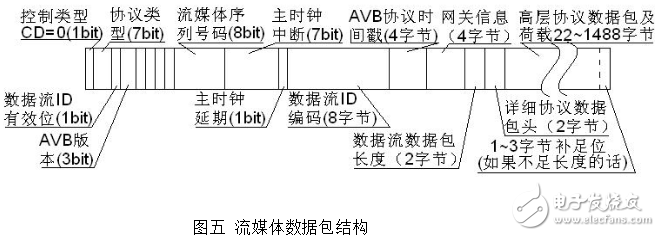Ethernet Audio/Video Bridging (also known as "EthernetAVB", hereinafter referred to as AVB) is a new IEEE 802 standard that limits bandwidth (Bandwidth) and limits latency (Latency) based on traditional Ethernet networks. ) Synchronized with precise clock (TIme synchronizaTIon) to support a variety of audio and video-based network multimedia applications. AVB focuses on enhancing the real-time audio and video performance of traditional Ethernet, while maintaining 100% backward compatibility with traditional Ethernet. It is a next-generation network audio and video real-time transmission technology with great development potential.
AVB advantage
Traditional audio and video (AV) device configurations have been single-use point-to-point one-way links. This dedicated connection mode results in a large amount of cabling required in professional and user applications that are difficult to manage and operate. There are a number of recognized mechanisms to address this issue. But all these mechanisms are not non-standard, or difficult to operate and configure, otherwise they are inflexible and expensive. Migrating to an Ethernet facility is a recognized approach to addressing the needs of professional AV equipment. However, at present, the configuration mechanism lacks flexibility and interoperability. In order to accelerate the adoption of Ethernet-based AV configurations that can be operated together, IEEE developed the IEEE802.1 Audio Video Bridging (AVB) standard.
AVB is a collection of IEEE 802.1 standards developed by the TIme-SensiTIve Networking Task Group to enhance the capacity of information exchange, industry support and standardization of AV products. Audio and video bridges are commonly referred to as switches, which are designed to provide time-synchronized, low-latency, and bandwidth-reserved streaming capabilities for audio and video data.
The goal of AVB is to deliver audio, video and other data forms using "smart" switches that can handle AVB traffic without affecting the unified integration of the network. With AVB, IT managers can adopt a hybrid data network that is more time-saving, cost-effective, and more efficient to perform as an AV system manager than parallel independent systems. Integrating AVB technology into today's IT systems is a huge advancement and will fundamentally shift the principles of most IT and AV administrators designing systems.
The VB transport protocol improves the inherent "congenital deficiency" of previous Layer 2 protocols such as CobraNet or EtherSound. Under the premise of greatly improving the control ability, the IEEE1394 technology is used to transmit synchronous professional audio/video signals under the three-layer protocol, and the transmission delay is compressed to the microsecond level.
The AVB transport protocol has three main definitions of data flow:1. Multimedia format and packaging method. Including raw data stream and compressed audio, video stream, and with the transmission of IEEE1394 (IEEE1394 interface is a serial standard developed by Apple, commonly known as firewire interface (firewire). Like USB, IEEE1394 also supports peripheral hot swap, can be external The power supply is provided, the power supply of the peripheral is omitted, and a plurality of different devices can be connected to support the synchronous data transmission.
2. Synchronization mechanism for streaming media delivery. Includes synchronization and loss reconstruction of the reference clock, as well as synchronous clock delay control and optimization.
3. Distribution of multicast addresses. This includes assigning an ID to the AVB data stream and how the media clock generator is allocated.

Audio Video Bridging (IEEE 802.1 AVB and IEEE 1722/1733) provides high quality of service for audio and video streaming across a hybrid network.
XMOS has developed a flexible, software-only configuration of AVB audio that can be configured to support a single stereo pair of more than 100 audio channels (via Ethernet). The deterministic architecture of the XMOS device perfectly matches the low latency and timing synchronization of the AVB, while the XMOS device also has the ability to integrate digital audio interfaces, TCP/IP and DSP processing control functions.
The AVB protocol suite basically spans all layers of the TCP/IP protocol suite, not just Layer 2 protocol transmissions, and is a routable protocol, which is essentially different from the Layer 2 CobraNet and EtherSound protocols in transmission. Although AVB can support Layer 3 routing, it does not mean that it can be sent to the Internet public network, or it can be configured on a VPN under the Internet architecture. This is because the reference clock delay problem of long-distance transmission has not been solved at all, and the network diameter still cannot exceed 7 hops. So, what are the benefits of this three-tier protocol? Due to the intervention of QoS, data management and transmission efficiency are greatly improved, and more TCP/IP-based hardware and management software can support AVB. This makes all aspects of AVB's capabilities very powerful and flexible. Although the AVB protocol set has just been described as having a wide variety of packet types, the basic frame structure of each different-purpose AVB packet is the same.
The above AVB packet structure is only its two-layer structure type, that is, the protocol structure for Layer 2 Ethernet transmission, and the Layer 3 transmission and control protocol is encapsulated in the AVB Ethernet payload (Payload) of 46 to 1500 bytes. It is additionally defined. If you don't understand the meaning of this sentence, you can refer to the relevant TCP / IP data structure related books, or refer to the chapter on CobraNet data structure packaging before this serial. Simply put, network packet encapsulation is a "nested" structure, the bottom layer of the second layer is the outermost package, the three-layer structure is embedded, and so on.
   AVB packet type
The structure of this AVB load is analyzed separately below, which is where AVB technology is completely different from previous CobraNet and EtherSound technologies. According to the packet type, the AVB data packet can be divided into two categories: command/control data packet and streaming media data packet. Below we will discuss it in two parts.
1. Command/Control Packet:

This data packet contains data structure packets other than streaming media signals such as command release and control signals, data stream reservations, etc., and belongs to the third layer data encapsulation package (router level). The first bit data bit is called the CD data bit, and there are only two representation states, "0" for streaming media data and "1" for control data. 4~11 This 8-byte 802.1Qat reservation data protocol ID number, which is equivalent to the IP address in the TCP/IP protocol set (for example, 192.168.0.1 is 4 bytes "0xC0A8 0x0001", indicating the destination address, The immediately following 192.168.0.1 is the sender address, so a total of 8 bytes. In the AVB protocol, because the sender and the receiver no longer use the IP address naming method, but use the identification ID to distinguish different Device, but its role and location in the packet is similar to the TCP/IP suite of protocols). The last 1~3 bytes of the complement is when the load data is short (ie, when the three-layer load is less than 34 bytes), the AVB control device automatically adds enough "0" to fill the digits, called "Padding" to prevent the formation of ultra-short frames. Ultra-short frame means that when the Ethernet packet is lower than 64 bytes (or more than 1518 bytes), the Ethernet transmission mechanism CSMA/CD cannot determine the spacing of adjacent received frames to form a network collision, in order to avoid such a collision. Occurs, Ethernet specifies the minimum and maximum length of each packet.
2, streaming media data stream package:

The data structure of streaming media data is obviously much more complicated than controlling data packets, but the basic meaning is not too complicated. The media stream data transmitted by AVB can be of many types, including compressed and uncompressed audio and video, and satellite TV data. These different types of data are available in the 7-bit protocol type in the media stream packet. reflect.
to sum up
The main difference between the packet structure of the AVB sending and receiving data streams and the previous Layer 2 transmission technology is:
·The system delay is greatly reduced to less than 2 milliseconds
· The system's transmission quality has QoS guarantee, including software and hardware support
· AVB as a carrier of streaming media, can transmit a variety of audio and video streaming media including compression and non-compression, and can ensure synchronous transmission, breaking through the bottleneck of the past
· Up to 256 different formats of audio and video data streams (including sampling frequency) can coexist in the same network without interference
· Support for advanced features of other Layer 3 protocols
These features indicate that it will be one of the next generation of streaming media file transfer standards, both in the professional and civilian fields, will show its powerful charm.
ZGAR bar 3000 Puffs
ZGAR electronic cigarette uses high-tech R&D, food grade disposable pod device and high-quality raw material. All package designs are Original IP. Our designer team is from Hong Kong. We have very high requirements for product quality, flavors taste and packaging design. The E-liquid is imported, materials are food grade, and assembly plant is medical-grade dust-free workshops.
Our products include disposable e-cigarettes, rechargeable e-cigarettes, rechargreable disposable vape pen, and various of flavors of cigarette cartridges. From 600puffs to 5000puffs, ZGAR bar Disposable offer high-tech R&D, E-cigarette improves battery capacity, We offer various of flavors and support customization. And printing designs can be customized. We have our own professional team and competitive quotations for any OEM or ODM works.
We supply OEM rechargeable disposable vape pen,OEM disposable electronic cigarette,ODM disposable vape pen,ODM disposable electronic cigarette,OEM/ODM vape pen e-cigarette,OEM/ODM atomizer device.

Disposable Vape, bar 3000puffs, ZGAR bar disposable, Disposable E-cigarette, OEM/ODM disposable vape pen atomizer Device E-cig
ZGAR INTERNATIONAL TRADING CO., LTD. , https://www.zgarvapor.com